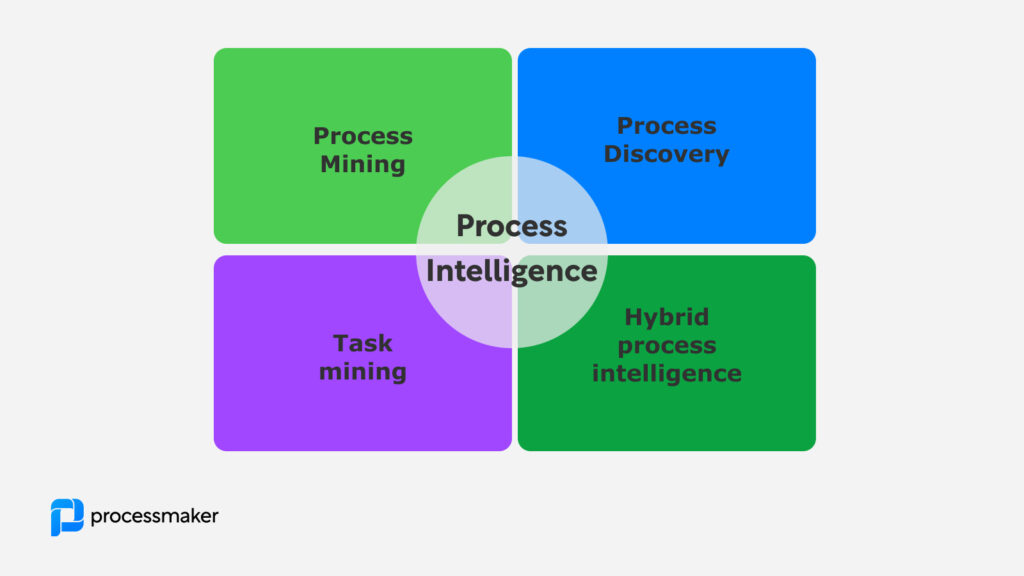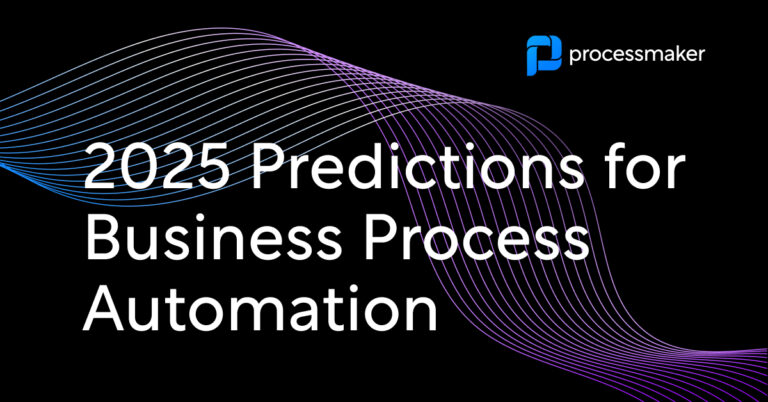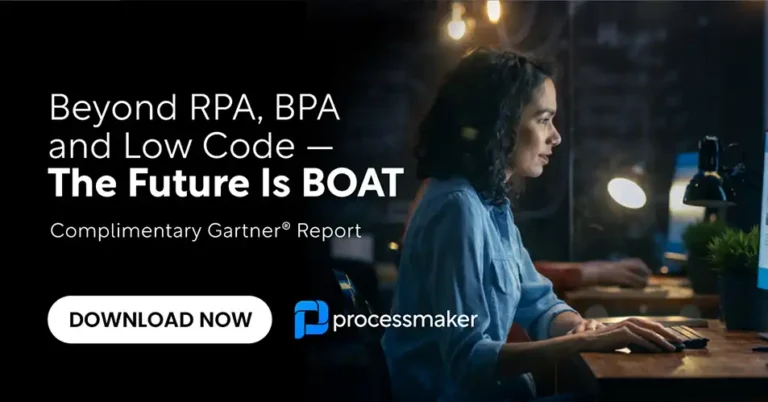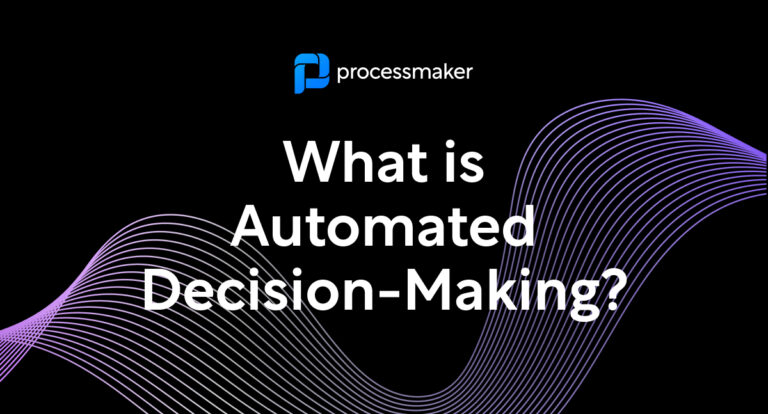As 2024 comes to a close, it is a good time to reflect on the state of the industry of business process automation. Whether you call it Business Process Automation, Business Process Orchestration, or if you are old school and prefer the term Business Process Management – the discipline has never been more relevant than today.
In some ways, nothing has changed in business process management. In other ways, everything has changed. What do I mean by that? Well, the discipline of mapping, automating, measuring, and improving business processes has not changed. It is still the core competitive advantage (or disadvantage) for the vast majority of businesses in the world. However, many may be confused and think everything is new because while the concepts and purpose remain the same, the technology landscape looks nothing like it did just a few years ago.
This is probably the most important thing to keep in mind when applying business process management in your company or creating a Center of Excellence (CoE) in process management. Don’t get distracted by the new acronyms and hype, the mission is still exactly the same – improve your business processes to achieve better results (financial, quality, NPS, and more).
So, with that short ramble of a preamble, let’s turn our focus to the hype and new technologies and see how they will change the world of business process automation.
1. Agentic AI
Everyone is eagerly waiting for the next versions of AI models and waiting for the AI capabilities in these models to have truly agentic properties. This means AI that could control the desktop (and do what RPA failed at doing) and control the internet (yes – book your tickets, get your Uber, and so much more for business AI).
Anthropic has already demonstrated the potential of agentic AI with its eye-opening desktop control demos. By 2025, agentic AI is expected to take center stage, likely beginning with consumer applications—such as travel bookings and scheduling doctor appointments. However, B2B won’t be far behind.
2. Process intelligence
The Gartner Market Guide for BPA Tools suggests that enterprises have been focusing on getting more transparency into “bottlenecks, inefficiencies, and the performance of their end-to-end business processes.”
As a result, many BPA companies sought to acquire process mining, task mining, and process monitoring capabilities that help gain visibility into business processes.
However, process mining or task mining alone are not able to cover end-to-end processes fully, so an inherently hybrid unified approach of process intelligence would be an answer.

Process intelligence helps to discover the current state of workflows, with all its variants, inefficiencies, and bottlenecks. Then, based on the status quo and the desired state, the technology helps to build a roadmap of how those inefficiencies can be improved through automation. It’s a groundbreaking technology that gives a complete 180 transparency and helps to evaluate the effectiveness of automation initiatives.
3. RIP RPA
RPA had its spotlight for some time. A Gartner analyst claims to have added the word “robotic” to what was essentially screen-scraping technology which significantly boosted the market value of companies like UiPath and others, adding billions of dollars to their valuation.
Easy come, easy go.
RPA is dead. But does this mean that RPA companies like Blue Prism, UiPath, and Automation Anywhere are doomed? Not necessarily, they are remaking themselves quickly. Let’s see how they do in 2025.
4. BOAT – Business Orchestration and Automation Technology
BOAT is a concept introduced by Gartner that is shaping conversations around the future of BPA. BOAT aims to redefine automation by integrating diverse technologies such as BPM, Robotic Process Automation (RPA), Integration Platform as a Service (iPaaS), Low-Code platforms, and Generative AI into a cohesive, end-to-end orchestration framework. But the big question remains—does BOAT signify a groundbreaking shift or is it simply a rebranding of existing tools?
BOAT stands apart by emphasizing seamless integration and adaptability. Unlike traditional BPM, which often relies on multiple solutions to manage workflows, BOAT proposes a model where businesses can address most automation needs with a single, unified platform. Embedded AI plays a central role in this approach, enabling smart, data-driven process adaptation and simplifying tasks like workflow creation through AI-powered automation. This holistic approach offers businesses a way to streamline fragmented strategies while enhancing scalability and speed.
Some argue that much of what BOAT represents—such as process orchestration, AI integration, and user-centric adaptability—has been evolving within existing platforms for years. Still, for businesses in 2025, the rise of BOAT could mean a move toward more consolidated systems that eliminate the inefficiency of disparate tools and bring orchestration to the spotlight. By merging technologies into a single ecosystem, BOAT empowers companies to achieve greater agility, improve user experiences, and unlock new opportunities for innovative automation.
Whether the term BOAT gains true traction or not, its focus on unification and next-generation orchestration is likely to drive meaningful advancements in BPA, enabling organizations to stay competitive in a rapidly evolving digital landscape.
5. BPMN – Business Process Model and Notation
What is BPMN?
BPMN is a standardized visual language used to map out business processes in a clear, detailed way. With its easy-to-understand flowcharts, BPMN helps teams identify process steps, decision points, and potential inefficiencies, making it easier to design, communicate, and implement automated solutions that align with business goals.
A Comeback?
BPMN is making a strong comeback as businesses revisit the importance of process and system orchestration. While newer concepts like BOAT generate buzz, BPMN continues to prove its enduring value. Once thought to be losing momentum like other modeling standards (e.g., XPDL), BPMN has remained not only relevant but more vital than ever in helping organizations manage and optimize their workflows.
What makes BPMN stand out is its ability to bring both technical and non-technical teams together to visualize and understand processes clearly. Its structured approach ensures everyone is on the same page, speeding up collaboration and helping teams work smarter.
BPMN also shines in how it handles exceptions, offering a reliable way to keep processes flexible and functional when unexpected challenges arise. Built on a strong foundation of global standards, it has remained trusted and adaptable through years of change. With its combination of clarity, adaptability, and reliability, it plays a key role in helping businesses streamline operations and prepare for the future.
BPMN is one of the best ways to handle complexity. Complexity inside business processes is about to mushroom out of control due to Agentic AI. The simple workflow solutions will just not be able to handle the management of these agents. Sure, there will be dedicated tools for managing Agents just like Mulesoft and other tools have managed connectors in the past. Call it iPaaS or call it ETL or Workload Automation – all of these tools will grab a piece of this opportunity. However, BPMN is unique in its ability to look at the actual “business” part of the problem and nicely blend it with the technical. AgenticAI sort of falls in between people and connector which could give BPMN orchestration solutions a big advantage here.
Far from fading into the background, BPMN is evolving alongside the industry, staking its claim as one of the most important tools for process automation in 2025 and beyond.
6. Death of Software-as-a-Service (SaaS)
Yes, SaaS will die. Ok, maybe it won’t happen in 2025, but the decline has undeniably begun. Remember, we can only interpret history looking backwards not forwards.
With over 30,000 SaaS solutions saturating the market, the cracks in the model are becoming impossible to ignore. While the “best-of-breed” approach once promised productivity gains, it has instead created a tangled web of tools that are costly, difficult to integrate, and overwhelming to manage. Businesses are now spending between $1,000 and $3,500 per employee annually on SaaS applications, a number that continues to rise.
AI, particularly Agentic AI, is positioned to fundamentally disrupt the SaaS ecosystem. Unlike traditional SaaS tools that each solve one specific problem but often lack seamless connectivity, AI can deliver integrated, holistic solutions that eliminate the need for dozens of separate applications (again – think about it like RPA that actually works!)
For SaaS companies, survival in the AI-driven era will require immediate adaptation. While SaaS has dominated the business world for years, 2025 may mark the tipping point where AI proves it can do more, for less, with fewer limitations.
7. Connectors
Connectors and iPaaS companies will become more important. AI, as with most things, will simply make it easier to connect systems and tools. Everyone is waiting for their ChatGPT-like assistant to not only recommend the best product to buy but also complete the purchase seamlessly. By 2025, this vision will become a reality. For those who dislike shopping, whether in person or online, the world will become even more convenient—AI will handle it all for you.
Integrating enterprise software has traditionally been a daunting and resource-intensive task, especially for businesses juggling a wide array of tools. Pre-built connectors for popular platforms like SAP, Salesforce, and HubSpot have long eased this burden. However, when it comes to connecting niche or highly specialized software, businesses have faced the costly and time-consuming challenge of creating custom connectors.
Maybe you won’t know that under the hood it is a Zapier, or a Snaplogic, or a Mulesoft connector.
Now, AI-powered BPA platforms are revolutionizing this process by simplifying and accelerating the creation of connectors. With AI streamlining the integration process, businesses will be able to automate entire workflows more efficiently and leverage their full software ecosystems.
8. Groq becomes the most powerful AI
By March next year, Groq will be trained on the largest serialized computer cluster ever conceived. Elon Musk was once again years ahead of anyone. He rebuilt the way we train models and is now able to join hundreds of thousands of processors. Groq is set to surpass all other models.
9. Chatgpt buys Mulesoft
Chatgpt will need to play catchup. It will deply design by doing rather than doing by design principals. It will need powerful AI agents. It will get these agents by purchasing an iPaaS company like mulesoft where it can assemble all the connections it needs on the fly with the AI in order to get meaningful work done.
ChatGPT will need to catch up by adopting a “design by doing” approach rather than traditional “doing by design” principles. To achieve this, it will require powerful AI agents. One potential strategy to acquire these agents could involve purchasing an iPaaS company like MuleSoft where it can assemble all the connections it needs on the fly with the AI in order to get meaningful work done.
10. Legacy Enterprise App – Rewriting
Forget costly migrations from legacy systems. Now, AI tools offer a groundbreaking alternative—they can analyze existing code bases and rewrite the application onto a modern tech stack, saving significant time and resources.
11. On-the-Fly Process Building
Processes will need to change—and they’ll need to change quickly. Think of it like an internet router. If one route becomes slower or more expensive, the router immediately redirects data packets through a better path. You rarely notice this happening. For instance, when you make a call from your Voice over IP (VoIP), the call might initially route through one carrier. But within minutes, network conditions could change, and the system will automatically switch to the most cost-effective route.
This kind of adaptability will soon define business processes. Processes will no longer rely on static rules to make adjustments. Instead, Agentic AI will enable dynamic decision-making, allowing processes to respond intelligently and in real time to changing conditions.
A Promising Year for Business Process Automation and Orchestration
2025 will definitely be an exciting year for BPA and orchestration.
From the rise of Agentic AI to the promises of BOAT and the enduring relevance of BPMN, the tools and technologies shaping this space are more powerful and dynamic than ever. While RPA gives way to more advanced solutions and SaaS faces its challenges, the ongoing evolution emphasizes growth and adaptability.
Businesses that can harness these advancements effectively will gain significant competitive advantages, driving efficiency, agility, and innovation across their processes. The shift isn’t just about technology—it’s about reimagining how work gets done. Buckle up, because 2025 promises to redefine what’s possible.






